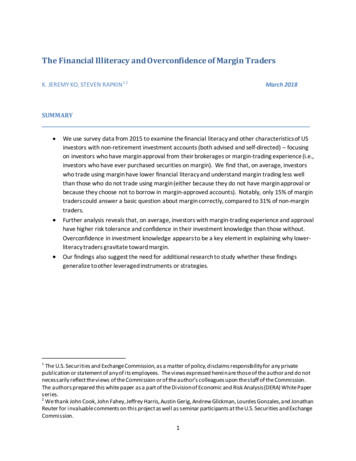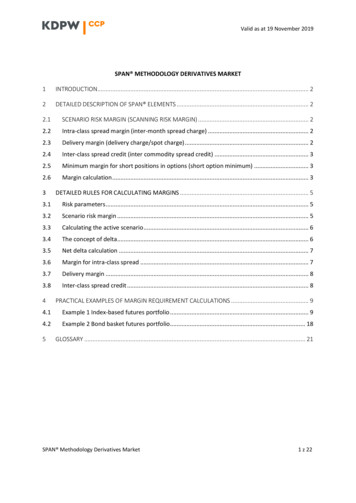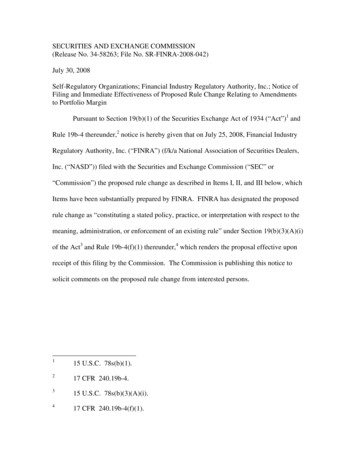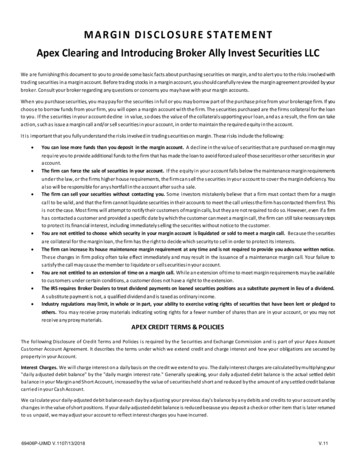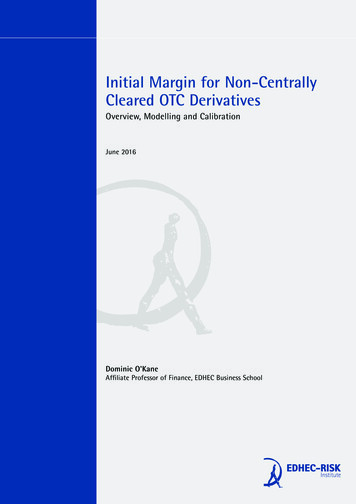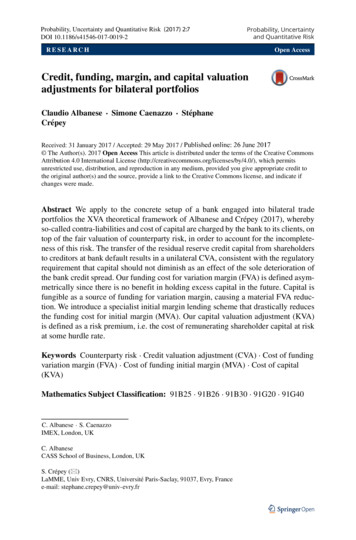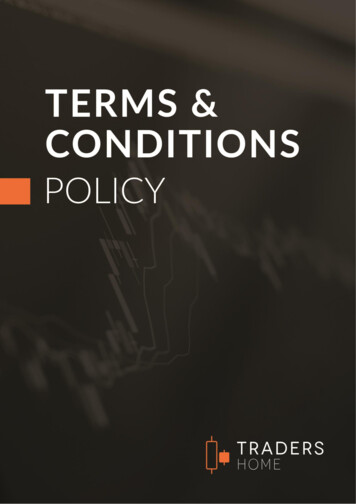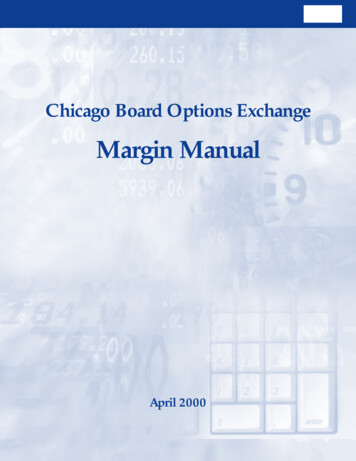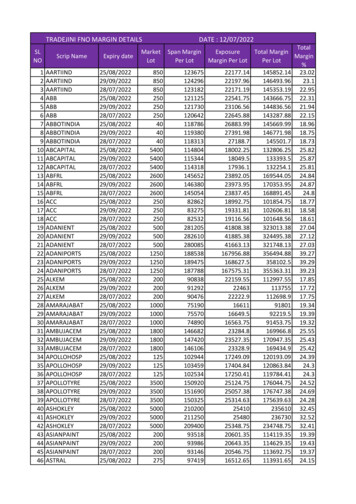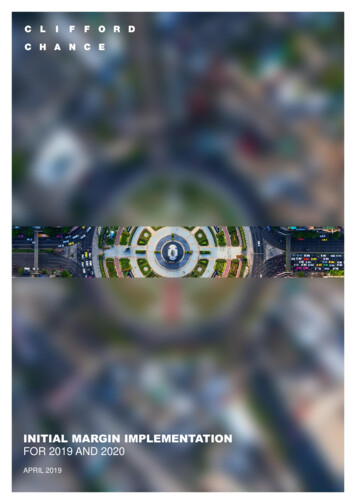
Transcription
INITIAL MARGIN IMPLEMENTATIONFOR 2019 AND 2020APRIL 2019
INITIAL MARGIN IMPLEMENTATIONFOR 2019 AND 2020Preparing for the Challenges of 2019 and 2020 InitialMargin ImplementationIn August 2018 the United Kingdom’s Financial ConductAuthority (FCA) published a research note which identified alikely ten-fold increase in firms needing to comply with theinitial margin requirements for uncleared derivatives (IM)following the final stage of the phased-in implementation inSeptember 2020. Many smaller banks and investment firms(including non-EU firms) will be impacted and will need toimplement for IM over the next two years and those firms needto start preparing now to avoid the inevitable bottleneck closerto the implementation deadlines.This briefing highlights the key implementation challenges forin-scope entities and the importance of preparing early.Scoping the challengeFirms will recall variation margin (VM) repapering projects, thethousands of new credit support annexes (CSAs) which had tobe agreed and the rush to meet the March 2017 deadline. Theimplementation challenge for IM is very different. Whilst theuniverse of entities within scope of IM is far narrower than forVM, for those that find themselves needing to implement forIM, the legal, operational, IT, liquidity and funding challengesfar exceed those associated with VM and in-scope entities arestrongly recommended to begin preparations as soon aspossible. The first task is for firms to identify whether or notthey are in-scope for IM (see Box 1 for eligibility criteria underEMIR). Entities not in-scope for VM will, by definition, also beout-of-scope for IM.If in-scope for VM, a group-wide calculation of aggregateaverage notional amount of uncleared OTC derivatives(AANA) is necessary. This calculation will need to be done forall jurisdictions and rule sets relevant to a trading relationship.For a smaller bank or investment firm facing a major bank ordealer, for example, this will likely include both European(EMIR) and US (CFTC and/or PR) rules, each with their ownexemptions and nuances, particularly when it comes tocalculation of AANA and the rules around consolidation forcertain entity types.ISDA has prepared a standard form of Information Letter(published 11 July 2018) which entities can use to indicate totrading counterparties whether they are likely to be in-scopefor IM in September 2019, September 2020 or not at all.DOCUMENTATION OVERVIEWEITHER (for bank custodians such as JPM or BNYM*)IM CSA/CSDISDA VM CSAAccountControl Agreement (ACA)EligibleCollateralSchedule OR (if Euroclear or Clearstream is itydocuments of Agreement Euroclear or ClearstreamEligibleCollateralSchedule*Note: Other custodians which maintain accounts outside New York or London may require aCollateral Transfer Agreement and Security Agreement instead of an IM CSA/CSDBOX 1: TESTS FOR SEPTEMBER 2019 AND SEPTEMBER 2020 IM IMPLEMENTATION UNDER EUROPEAN RULESAn EU entity will be in-scope of IM under the European rules if: it is in-scope for VM; it or its “group” has an aggregate average notional amount of non-centrally cleared derivatives (AANA) that is above EUR 750billion (September 2019) or EUR 8 billion (September 2020). This is based on the average of the total gross notional amount ofall non-centrally cleared OTC derivative contracts of the entity and its group recorded as of the last business day of March,April and May of 2019 (for September 2019) or 2020 (for September 2020); and it trades non-centrally cleared derivatives with other entities in-scope of IM. Entities that are not established in the EU can be in-scope for IM if the entity would be in-scope for VM if it had beenestablished in the EU and it trades with another entity that is directly in-scope or another entity where there is a direct,substantial and foreseeable effect in the EU.INITIAL MARGIN IMPLEMENTATION FOR 2019 AND 2020CLIFFORD CHANCE
VM VS. IM documentationVM CSAIM documentationMethod of collateralisationTitle transferSecurity interestWhere is the collateral held?The counterpartySegregated account of custodian/clearing systemsecured in favour of the counterpartyHow is the quantum ofcollateral calculated?Mark-to-market as per the“Exposure” definition in VM CSAIn accordance with regulatory requirements, ISDA SIMMor grid methodOne-way or two-waycollateral posting?Two-wayOne-way or two-wayThe Legal DocumentationAll jurisdictions which have implemented IM requirementsrequire collateral posted as IM to be held on a segregatedbasis. This usually means that a party to a trading relationshipwill post IM into a segregated account held with a custodianwhich will then be secured under the relevant law in favour ofthe trading counterparty. The trading counterparty will do thesame, although it may well use a different custodian for theposting of its IM. As new-in-scope entities seek to use theirexisting custodians and depositories for IM posting, the rangeof custodians offering initial margin services is increasing.The segregation requirement complicates the legaldocumentation significantly. CSAs used for VM cannot beused for IM collateral posting as they do not support asegregated collateral model. ISDA has published a dedicatedsuite of documentation for IM (including a New York law CSA,an English law credit support deed, a Japanese law CSA andsimilar local law documentation if Euroclear or Clearstreamare to be used as custodian).INITIAL MARGIN IMPLEMENTATION FOR 2019 AND 2020(While both parties will be required to post, each partymay post under separate IM documentation, dependingon the custodians being used)ISDA has provided “next generation” IM documentationupdated specifically for the 2019 and 2020 phases. Thisdocumentation will need to be negotiated with each in-scopetrading counterparty, including bank and dealercounterparties.In addition, custody documentation will need to be agreed.Each party will select its custodian of choice. As a result, anyin-scope entity will need to review and negotiate not only thecustody documentation for its own custodian, but also thedocumentation for each custodian used by any of itstrading counterparties.The range of documentation that any one in-scope entity willneed to negotiate and agree (both as collateral taker andcollateral receiver) with trading counterparties and custodians,together with the complexity of that documentation stemmingfrom the need to meet the mandatory segregationrequirements, highlights both the difference in thedocumentation challenge to VM implementation and the time ittakes to implement for IM.CLIFFORD CHANCE3
Beyond the documentationIM implementation is more than just a legal anddocumentation exercise: Operations – each in-scope entity will need to on-boardwith the relevant custodians. KYC checks will need to becompleted and accounts opened, and protocols will need tobe agreed for the day-to-day operation of segregatedaccounts. In addition, operational functionality will need tobe built to support the determination of the amount of IMwhich must be exchanged. IT – IT systems will need to be updated to achieveconnectivity with custodians’ systems and to reflect thenew IM arrangements more generally, with time allowedfor testing. Liquidity and Funding – in-scope entities will need tosource liquid assets to post as IM collateral. Whilst an inscope entity may wish to post cash, many custodians arereluctant to accept cash and there are regulatoryrestrictions on the use of cash under certain rule sets. Also,unlike collateral posted as VM, posted IM collateral cannotbe reused or rehypothecated by the collateral taker.Potential impact of BrexitThe timetable for the implementation of IM coincides with theimplementation of Brexit projects by buy- and sell-sidecommunities alike. Brexit-driven transfers of derivativeportfolios could result in the quantum of required IM increasingand changes in the location of parties (including custodiansthemselves) complicates the legal and documentation analysis.The Brexit overlay is certainly an issue to keep in mind whilstplanning and implementing for IM.Given the scope of the challenges of implementing IMhighlighted above, we would recommend that those which arelikely in-scope of IM should commence their projects as soonas possible. In the worst case, in-scope entities which have notimplemented IM by the regulatory deadline may not be able totrade non-centrally cleared OTC derivatives with theircounterparties. Having acted for dealers and custodians inearlier phases of IM implementation and for asset managers,pension funds, insurance companies and funds on VMimplementation, Clifford Chance are well placed to adviseentities coming in to scope on their 2019 and 2020 IM projects.Will the EUR/USD 50 million threshold makeposting unnecessary?Both the European and US rules allow parties not to post IM ifthe group-wide amount of IM which would otherwise berequired does not exceed EUR/USD 50 million. This isexpected to mean that a significant proportion of in-scopeentities will never in practice post IM, with those close to thethreshold incentivised to manage their derivatives portfolio tostay under the threshold. Under the current rules, parties underthe threshold will still need to agree all the necessarydocumentation and systems set out above, notwithstanding thefact that no IM is exchanged.However, in March 2019 BCBS IOSCO published a statementaimed at providing guidance to support timely and smoothimplementation of the margin framework and to clarify itsrequirements. In particular, the statement commented on thefact that in 2019 and 2020 IM requirements will apply to a largenumber of entities for the first time, potentially involvingdocumentation, custodial and operational arrangements. BCBSIOSCO noted that the margin framework does not specifydocumentation, custodial or operational requirements if thebilateral IM amount does not exceed the framework’sEUR/USD 50 million IM threshold. Regulators in the US andEU have not yet commented formally on the statement, but it ispossible that we will see guidance or amendments to rules toreflect the BCBS IOSCO statement.CLIFFORDCLIFFORDCHANCECHANCE
CONTACTSJAMES GEERSenior AssociateLondonCAROLINE DAWSONSenior AssociateLondonWILLIAM WINTERTONPartnerLondonLAURA DOUGLASSenior AssociateLondonMARIA LUISA ALONSOCounselMadridT 44 207006 4295E james.geer@cliffordchance.comT 44 20 7006 4355E caroline.dawson@cliffordchance.comT 44 20 7006 4386E will.winterton@cliffordchance.comT 44 20 7006 1113E laura.douglas@cliffordchance.comT 34 91 590 7541E marialuisa.alonso@cliffordchance.comMARC BENZLERPartnerFrankfurtANNA BIAŁACounselWarsawLUCIO BONAVITACOLAPartnerMilanLOUNIA CZUPPERPartnerBrusselsPAGET DARE BRYANPartnerLondonT 49 69 7199 3304E marc.benzler@cliffordchance.comT 48 22429 9692E anna.biala@cliffordchance.comT 39 02 8063 4238E lucio.bonavitacola@cliffordchance.comT 32 2 533 5987E lounia.czupper@cliffordchance.comT 44 20 7006 2461E paget.darebryan@cliffordchance.comFRANCIS EDWARDSPartnerHong KongDAVID FELSENTHALPartnerNew YorkSTEVE JACOBYPartnerLuxembourgFRÉDÉRICK LACROIXPartnerParisLENG-FONG LAICo-Managing PartnerTokyoT 852 2826 3453E francis.edwards@cliffordchance.comT 1 212 878 3452E david.felsenthal@cliffordchance.comT 352 48 50 50 219E steve.jacoby@cliffordchance.comT 33 1 4405 5241E frederick.lacroix@cliffordchance.comT 81 3 6632 6625E leng-fong.lai@cliffordchance.comSARAH LEWISAssociateAmsterdamKIMI LIUSenior AssociateBeijingLENA NGPartnerSingaporeGARETH OLDPartnerNew YorkJEREMY WALTERPartnerLondonT 31 20 711 9630E sarah.lewis@cliffordchance.comT 86 10 6535 2263E kimi.liu@cliffordchance.comT 65 6410 2215E lena.ng@cliffordchance.comT 1 212 878 8539E gareth.old@cliffordchance.comT 44 20 7006 8892E jeremy.walter@cliffordchance.comINITIAL MARGIN IMPLEMENTATION FOR 2019 AND 2020CLIFFORDCLIFFORDCHANCECHANCE
OUR INTERNATIONAL NETWORK32 OFFICES IN 21 COUNTRIESClifford Chance, 10 Upper Bank Street, London, E14 5JJ Clifford Chance 2019Clifford Chance LLP is a limited liability partnership registered in England andWales under number OC323571Registered office: 10 Upper Bank Street, London, E14 5JJWe use the word 'partner' to refer to a member of Clifford Chance LLP, or anemployee or consultant with equivalent standing and qualificationsThis publication does not necessarily deal with every important topic orcover every aspect of the topics with which it deals. It is not designed toprovide legal or other advice.www.cliffordchance.comAbu Dhabi Amsterdam Barcelona Beijing Brussels Bucharest Casablanca Dubai Düsseldorf Frankfurt Hong Kong Istanbul London Luxembourg Madrid Milan Moscow Munich Newcastle New York Paris Perth Prague Rome São Paulo Seoul Shanghai Singapore Sydney Tokyo Warsaw Washington, D.C.Clifford Chance has a best friends relationship with Redcliffe Partners in Ukraine.Clifford Chance has a co-operation agreement with Abuhimed Alsheikh Alhagbani Law Firm in Riyadh.
the trading counterparty. The trading counterparty will do the same, although it may well use a different custodian for the posting of its IM. As new-in-scope entities seek to use their existing custodians and depositories for IM posting, the range of custodians offering initial margin services is increasing.
